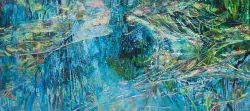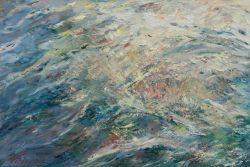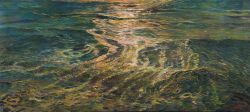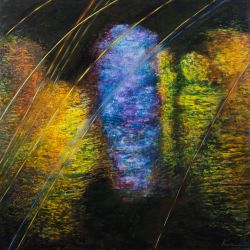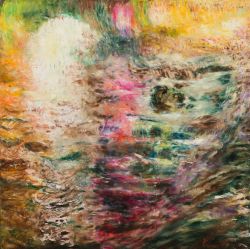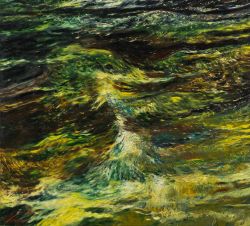Ekaterina Vorona
DREAMSCAPE
Curator Gianluca Marziani
Opening: 14 February 2019, at 18.30
Exhibition: 15 February - 28 February 2019
Ekaterina Vorona from Moscow exhibits the outcome of her artistic production over the past five years. Hers is a clean figurative distillation of aquatic landscapes, a homogenous vision that with silent but significant conceptual movements, revisits European art developments of the late 1800s.
Historical avantgardes remain an object of enquiry among those that grapple with landscapes. Landscapes, along with portraits, have always been the painting genre par excellence; it has endured since the age of petroglyphs, when walls of caves were canvasses that gave birth to drawings of hunting and of moments of joy. The dialogue between Man and Nature, our ambition to discover and conquer, the genesis of all civilisations, it is all expressed in landscapes. The gaze of the painter, that odd incorporation of a myriad of useful prophecies, has often seen the landscape as a utopic or alternative reality; with a cue to what has been promised (Eden), or a coded warning of what can become (destruction). The contemporary version of metaphysical landscapes implies artists in new queries: how to renew its identity, what to conserve and what to discard of the past, how to integrate a complex present into what has been summoned. The painting is faced with the dilemma of resilient fundaments and archetypes, that provide continuity to the ideal shape in our own changeable time. Artists pursue a landscape that unites the substance of the avantgarde with the cloaks of their own habitat, creating a prismatic mirror of a private but shared experience, polyglot and empathic, unbound by space and time.
Artists like Ekaterina Vorona operates in the sulcus acquired by the avantgardes, linguistic values that History has rendered essential. Memory, let it be clear, remains a peripherical anchorage, otherwise her work would be reduced to reflective mannerism, to an expression that absorbs but doesn’t elaborate. The contemporary approach fills the perimetry (memory) with specific surfaces, regulated by the mongrel temperature of a technological era. The new landscapes are transformed into those mental spaces where knowledge is preserved for a shifting future, using the logic of repetition to construct a structure with new patterns. Claude Monet is the filiation that contains the intentions and consequences of the project; light and colour are emotional variables, atmosphere the sentimental generator, patience the recurring rhythm. Vorona ventures into these outdoor landscapes, she merges with them methodologically and slowly, recovering in the painting the strength of the immense Russian landscapes, the force of the seasons, the vigour with which the seasons change. The physical immersion simultaneously becomes a journey in surreal surroundings, difficult to explain with words, a dive beyond the contingencies of ordinary life, in silent accord with Monet’s glances at Giverny’s water lilies.
Acquatic landscapes produced by a slow transformative process, by a patient observation of seas, lakes, rivers, springs, and brooks, and any other liquid source. The artist recovers an undamaged bond with the natural world, a sort of new consciousness of uncontaminated elements, and of places that contains a database of archaic times. Her spaces are silent fragments of a planet at risk, ambiances that express the beauty of lost paradises and the carefree simplicity of a world without technology. Vorona moves in the cinematographic groove of Terrence Malick, the laic cult of a mystical landscape that winds up the poetic thought. It is as if Monet blended with Malick’s panoramic airplanes, as if the French studies of variables in light, expanded to the digital light of the present.
Whirlpools, waves, reverberations and reflections, wakes and flows… the paintings suspend the articulation of time and in a metaphysical heartbeat, we are catapulted into the luminous nature of captivating mental visions. The glance departs from the perspectives of specific places and slides into a meditating silence, in the acoustic sound of natural elements, in the ever more urgent search for something primordial. It is a style of painting that contemplates the complexity of light, the spiritual theme of luminous vibrations, the meditative powers that tonal scales have over our senses. A journey outside urban times, away from the frenetic rhythm of progress, to bring our attention back to the internal noise of natural elements, to give back emotional substance to paintings, to calibrate impressionist research in light of the technological values of the present.

